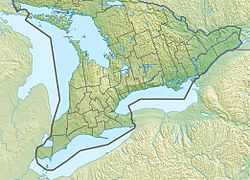| Beatty Saugeen River | |
|---|---|
| Location | |
| Country | Canada |
| Province | Ontario |
| Region | Southwestern Ontario |
| County | Grey |
| Municipalities | |
| Physical characteristics | |
| Source | Woods |
| • location | Boothville |
| • coordinates | 44°07′38″N80°36′38″W / 44.12722°N 80.61056°W |
| • elevation | 484 m (1,588 ft) |
| Mouth | South Saugeen River |
• location | Hanover |
• coordinates | 44°08′04″N81°01′33″W / 44.13444°N 81.02583°W |
• elevation | 261 m (856 ft) |
| Length | 46 km (29 mi) |
| Basin size | 274 km2 (106 sq mi) |
| Discharge | |
| • average | 5.7 m3/s (200 cu ft/s) |
| Basin features | |
| River system | Saugeen River |
The Beatty Saugeen River is a river in the Saugeen River and Lake Huron drainage basins in Grey County, southwestern Ontario, Canada. It is a tributary of the South Saugeen River which is itself a tributary of the Saugeen River.
